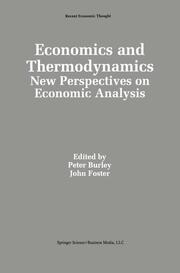-
Zusatztext
-
Over the past two decades we have witnessed something of a revolution in the natural sciences as thermodynamic thinking evolved from an equilibrium, or 'classical', perspective, to a nonequilibrium, or 'self organisational' one. In this transition, thermodynamics has been applied in new ways and in new fields of inquiry. Chemical and biological (evolutionary) processes have been analysed, increasingly, in non equilibrium thermodynamical terms. Economics has, since the late 19th century, relied heavily upon metaphors and analogies derived from the natural sciences - mechanical analogies cast in terms of traditional Newtonian physics and expressed in terms of Cartesian logic have been especially popular. Thermodynamics, on the other hand, has been less popular, despite its early application in economics by Stanley Jevons, the father of modern notions of utility maximisation in neoclassical economics, and despite its promotion in economic contexts by Paul Samuelson, the author of the definitive treatise upon which post war neoclassical economic theory was based, namely, his Foundations of Economic Analysis. The general neglect of thermodynamic thinking in economics was brought to our attention by Nicholas Georgescu-Roegen in the late 1960s, by which time economic theory, evidenced in, for example, the Arrow Debreu general eqUilibrium system, had become so sophisticated that it could not be penetrated by thermodynamical ideas. To Georgescu Roegen, this presented something of a crisis in economics because neglect of thermodynamics led, in his view, to blindness amongst economists to an economy/environment problem in the global economy.
-
-
Kurztext
-
Offers insights into research focusing on the interface between thermodynamics and economics. Although nonequilibrium thermodynamics and self-organisation appear to offer more possibilities for economic application, the papers in this volume demonstrate that economic insights are still derivable from the standpoint of classical thermodynamics.
-
-
Autorenportrait
- InhaltsangabeIntroduction. 1. An Essay in Macroeconomics; A. Bródy, K. Martinás, K. Sajó. 2. The Use of Thermodynamic Models in Economics; A. Bródy. 3. A Survey of Thermodynamical Ideas; J.R. Christie. 4. Economic Development as an Escape from Full Employment Entropy Ceilings; P. Burley. 5. Comparative Thermodynamics in Chemistry and Economics; J.A. Reiss. 6. A Non-Equilibrium Evolutionary Economic Theory; R.U. Ayres, K. Martinás. 7. Conservation of Mass and the Time Behaviour of Ecological-Economic Systems; C. Perrings. 8. Entropy, Liberty and Catastrophe: the Physics and Metaphysics of Waste Disposal; M. O'Connor. 9. The Self-Organisation Approach in Economics; J. Foster. 10. A Thermodynamic Analysis of Library Operation; G.J. Troup. 11. From Entropy to Economy: a Thorny Path; C. Dyke. 12. Thermodynamics and Chaos in Economic Prediction; G.C. O'Brien. Index.
Detailansicht
Economics and Thermodynamics:
New Perspectives on Economic Analysis, Recent Economic Thought 38
ISBN/EAN: 9780792394464
Umbreit-Nr.: 1571420
Sprache:
Englisch
Umfang: vii, 258 S.
Format in cm:
Einband:
gebundenes Buch
Erschienen am 31.08.1994


